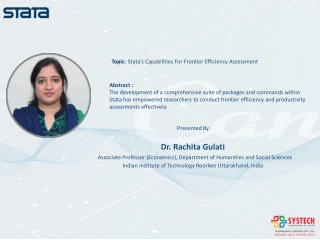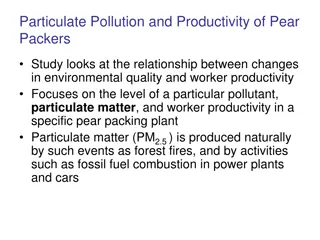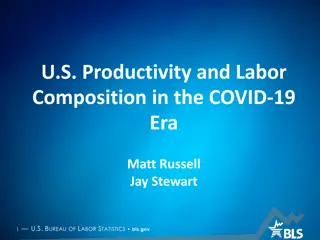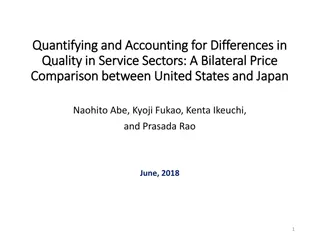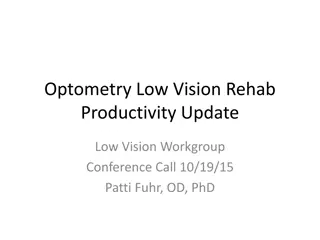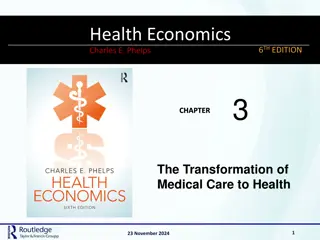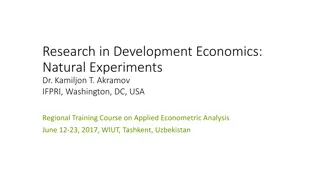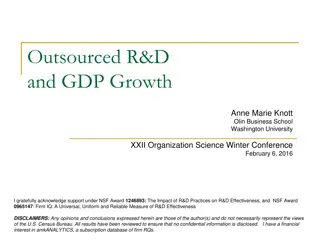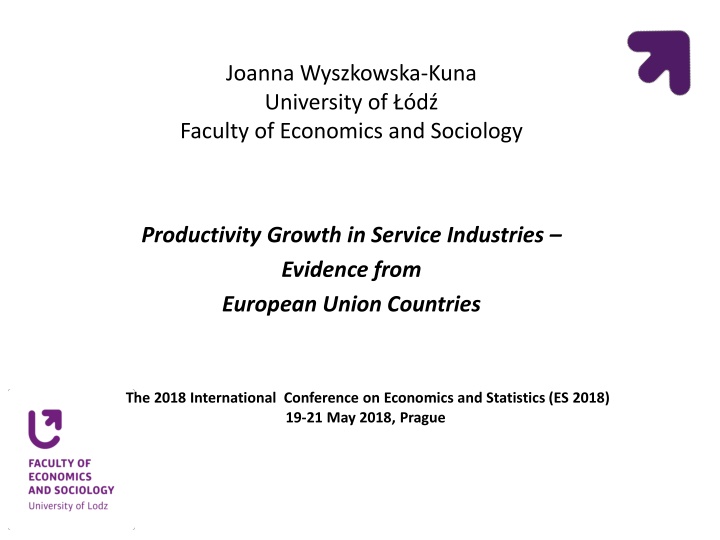
Productivity Growth in Service Industries: Evidence from EU Countries
Explore the research by Joanna Wyszkowska-Kuna on Total Factor Productivity growth in service sectors compared to agriculture and industry in European Union countries from 1995-2015. Discover the impact of technology on productivity improvements and challenges in measuring service sector productivity growth.
Download Presentation

Please find below an Image/Link to download the presentation.
The content on the website is provided AS IS for your information and personal use only. It may not be sold, licensed, or shared on other websites without obtaining consent from the author. If you encounter any issues during the download, it is possible that the publisher has removed the file from their server.
You are allowed to download the files provided on this website for personal or commercial use, subject to the condition that they are used lawfully. All files are the property of their respective owners.
The content on the website is provided AS IS for your information and personal use only. It may not be sold, licensed, or shared on other websites without obtaining consent from the author.
E N D
Presentation Transcript
Joanna Wyszkowska-Kuna University of d Faculty of Economics and Sociology Productivity Growth in Service Industries Evidence from European Union Countries The 2018 International Conference on Economics and Statistics (ES 2018) 19-21 May 2018, Prague
Aim: To examine TFP growth in the service sector in comparison with total economy, agriculture and industry (including the manufacturing sector), as well as within the service sector Method: The decomposition of output volume growth (Jorgenson and Griliches, 1967; Jorgenson et al., 1987) Data: EU KLEMS Release 2017 ES 2018 Prague 2018
Covered period: 1995-2015 (in the case of some countries it is shorter). It is divided into three sub-periods: 1995-2007, 2008-2010 and 2011-2015. Covered countries: Those EU countries for which it is possible to calculate TFP growth because of the lack of data on capital input for Belgium, Ireland, Portugal, Bulgaria, Latvia, Croatia, Cyprus, Malta and Romania these countries are excluded from the study. ES 2018 Prague 2018
Productivity growth in services Fourastie (1954) was the first to note that technological progress and the resulting productivity growth is diversified in particular sectors of the economy its rate is moderate in agriculture, high in industry, and low in the service sector. In a result, for a few decades there was a belief that that the shift towards an economy with a larger share of services (in employment and value added) might imply a reduction in the rate of productivity growth (Baumol, 1967; Baumol et al., 1985, 1989). The ICT revolution has contributed to the increasing use of the latest technologies in some service industries (banking, communications, telecommunications, transport, insurance, education, science, and healthcare), which has created some new opportunities for productivity improvement of the service sector. ES 2018 Prague 2018
Productivity measurement services Since the 90s. the number of papers on productivity growth in services have increased, but they generally proved that productivity improvement in services are harder to achieve than in goods producing industries:Triplett and Bosworth (1999, 2003); Mulder (1999); Mairesse and Kremp (1993); Baumol (1967, 2002); Baumol, Blackman and Wolf (1994); Licht and Moch (1999); Ark, Monnikhof and Mulder (1999); Gr nroos and Ojasalo (2004); Bal (2004); Sahay (2005); Djellal and Gallouj (2008); Savona and Steinmueller (2013); Biege et al. (2013); Grassano and Savona (2014). In the meantime, the studies indicating problems with the measurement of service productivity and the resulting high probability of the underestimation of productivity growth in service industries have developed (Meyer, 1987; Reckenfelderb umer, 2008). ES 2018 Prague 2018
Productivity measurement services Productivity measurement concepts have been deeply rooted in the context of mass manufacturing. They are based on contrasting input and output. Measuring the productivity of services raises problems with measuring the output of service activities due to their peculiarities, such as: intangibility, heterogeneity, inseparability and perishability. The customer is always a part of the service and hence the customer actions need to be considered on the input side and consequently quantifying customer co-operation is necessary (Blois, 1985; Gr nroos, 1990). Furthermore, service readiness, which is the major prerequisite of service delivery, also needs to be incorporated into measuring productivity. ES 2018 Prague 2018
Productivity measurement services With the improvement of measurement methods, some better results for productivity growth in service industries can be expected. The construction of EU KLEMS and WIOD databases gave the opportunity to calculate TFP growth for different countries on comparable basis. However, even in these cases, one should note the risk of lower reliability of data on service industries than on manufacturing industries when constructing these databases a variety of additional data sources were used, which are generally less numerous and often more incomplete in the case of service industries (O'Mahony and Timmer, 2009). Finally, according to Hershey and Blanchard (1980) problems can result from concentrating on increased productivity defined as output. They suggest effectiveness of the firm is a better productivity measurement. The value added concept provides an index for monitoring the effectiveness of the effort put in by the employees in obtaining market situation (Vrat et al., 1998). Therefore, in the present study TFP is calculated based on value added (as it is also suggested in the recent edition of EU KLEMS). ES 2018 Prague 2018
,,, Methodology j = (1, 2, , n), and ES 2018 Prague 2018
Methodology Labour input is the number of hours worked by persons engaged (EU KLEMS, 2017). The category persons engaged is broader than the category employees , because it includes, in addition to employees, self-employed workers (Timmer et al., 2007: 25). Capital input is the value of real fixed capital assets in 2010 prices multiplied by the number of hours worked per person engaged (EU KLEMS, 2017). The number of hours worked per person engaged is used as an indicator showing the shift-factor, i.e. the degree to which capital assets are used in the analyzed period, depending on the economic situation. Labour compensation is the compensation of all persons engaged, while capital compensation (EU KLEMS, 2017) is derived as gross value added minus labour compensation (O'Mahony and Timmer, 2009: 380). ES 2018 Prague 2018
Industries (NACE Rev. 2) o o o o TOT Total industries A Agriculture B Mining and quarrying C Manufacturing F Construction S Total services: G Wholesale and retail trade; repair of motor vehicles and motorcycles; H Transportation and storage; I Accommodation and food service activities; J Information and communication (Publishing, audiovisual and broadcasting activities 58-60; Telecommunications 61; IT and other information services 62-63); K Financial and insurance activities; L Real estate activities; M-N Professional, scientific, technical, administrative and support service activities; O-U Public administration and defence; compulsory social security O; Education P; Health and social work Q; Arts, entertainment, recreation and other service activities R-S; Activities of households as employers; undifferentiated goods- and services- producing activities of households for own use T; Activities of extraterritorial organizations and bodies U. o o o o ES 2018 Prague 2018
Industries (NACE Rev. 2) MS market services without public services, i.e. O, P, Q and T-U (which are usually omitted). KIBS knowledge-intensive business services: o J62-63 Computer programming, consultancy and related activities; information service activities; o M69-70 Legal and accounting activities; activities of head offices; management consultancy activities; o M71 Architectural and engineering activities; technical testing and analysis; o M72 Scientific research and development; o M73 Advertising and market research. ES 2018 Prague 2018
Average annual TFP growth rate in the EU-12 and EU-6(7) in the period 1995/2000-2007 (in pp) 8 5.79 6 4 2.78 2.32 2.28 1.77 1.63 2 EU-12 0.93 0.73 0.53 -1.03 EU-6/7 0 TOT A B C F Services MS KIBS -2 -4 -6 ES 2018 Prague 2018
Average annual TFP growth rate in the EU-12 and EU-6(7) in the period 2008-2010 (in pp) 6 3.72 4 2 0.59 0.54 -0.6 -0.5 -0.83 -1.79 -0.52 0 EU-12 TOT A B C F Services MS KIBS EU-6/7 -0.95 -2 -1.72 -4 -6 -8 ES 2018 Prague 2018
Average annual TFP growth rate in the EU-12 and EU-6(7) in the period 2011-2014/15 (in pp) 8 6 4 EU-12 2.06 2 EU-6/7 0.89 0.68 0.82 0.46 0.5 0.53 0.34 0.32 -0.1 0 TOT A B C F Services MS KIBS -2 -4 ES 2018 Prague 2018
Average annual TFP growth rate in the period 1995-2015 (in percentage points) AUT 08-10 -0,3 -0,4 -9,5 -2,4 -5,8 0,8 0,3 0,2 GER -0,6 -12,8 1,0 1,1 2,0 -1,1 -2,0 -3,5 LUX -0,7 0,8 -9,8 -3,8 1,2 -0,6 0,1 -4,9 DNK 08-10 0,6 16,6 -1,8 1,4 -2,6 0,4 1,0 -0,6 GBR -0,1 -11,7 -5,4 1,8 0,3 0,3 0,6 1,0 NLD -0,6 2,3 1,8 -1,3 -4,5 -0,2 -0,9 -1,1 FIN 08-10 -1,6 5,8 13,0 -4,5 3,0 -1,2 -1,5 -2,7 GRC -1,8 4,8 -1,7 -4,6 8,4 -2,4 -4,5 -13,2 ESP 0,2 0,1 -3,2 -0,6 0,0 0,2 -0,7 -1,0 FRA 08-10 -0,6 3,5 -3,8 1,9 -3,1 -0,6 -1,0 -1,9 ITA -0,9 1,1 -8,7 0,2 -4,2 -0,8 -0,8 -1,6 SWE -1,4 -4,6 -9,6 1,3 -3,8 -1,4 -2,5 -0,4 95-07 1,2 5,6 1,9 2,6 -0,1 0,6 0,6 -0,1 11-15 0,6 4,4 -5,4 0,7 -0,6 0,3 0,3 0,1 95-07 0,4 4,1 1,5 1,3 -0,6 0,2 0,2 -1,9 11-15 0,8 9,4 -11,5 3,1 2,6 0,8 0,5 2,3 95-07 2,4 2,7 0,2 6,4 -0,4 0,8 1,3 0,6 11-15 -0,7 2,2 -8,0 -0,6 -1,0 -0,6 -0,5 1,1 95-07 0,8 3,2 -0,7 2,9 -0,3 0,6 2,0 -1,1 11-15 0,6 0,6 -1,3 1,1 -1,1 0,7 0,3 -0,2 TOT A B C F Services MS KIBS TOT A B C F Services MS KIBS 1,3 5,1 0,3 3,1 -0,2 0,9 1,3 -2,0 0,5 -0,9 -0,3 0,5 -0,6 0,6 0,8 1,5 0,9 3,4 1,0 2,3 0,1 0,9 1,1 2,2 -0,3 1,8 -9,5 -0,1 -1,8 0,2 0,7 2,1 1,1 -0,8 3,2 1,0 2,0 0,8 0,4 -4,0 -0,8 2,7 -0,5 1,1 -4,4 -0,8 1,7 -6,5 0,0 1,5 -1,7 0,5 -1,2 -0,1 -0,2 -2,3 0,3 -0,2 9,8 1,0 1,6 0,1 0,2 -0,3 TOT A B C F Services MS KIBS 0,6 1,0 -1,3 1,4 1,0 0,5 0,5 -5,2 0,1 6,7 -4,2 8,5 -3,2 -0,3 -0,5 2,2 0,8 2,5 -2,2 2,8 1,2 0,7 1,0 -0,3 0,7 0,8 -10,2 0,6 2,3 0,8 0,9 1,5 -1,2 3,3 -1,7 0,0 -4,1 -0,4 -0,6 -3,8 0,6 0,5 -9,6 3,0 -0,3 0,7 1,1 1,3 1,1 3,5 -2,2 4,0 0,7 0,4 1,1 0,6 0,1 -1,6 -15,8 -1,1 -4,7 1,2 2,2 1,8
Average annual TFP growth rate in the period 1995-2015 (in percentage points) LTU 08-10 -3,6 0,6 -7,1 0,9 -13,5 -4,0 -4,8 -10,1 SVN 08-10 -1,0 -7,5 -5,1 1,6 -7,0 -1,0 -2,2 -1,1 CZE 08-10 -1,1 1,0 -3,5 1,3 -2,1 -1,0 -1,6 -4,1 EST 08-10 0,5 6,3 -2,6 3,9 4,7 -1,2 -0,5 -1,6 SVK 08-10 -1,0 -7,5 -5,1 1,6 -7,0 -1,0 -2,2 -1,1 95-07 1,7 -0,7 -2,7 4,8 -2,7 0,6 0,7 -0,2 HUN 11-14 1,3 5,7 5,8 0,5 3,8 1,0 0,9 -3,5 11-14 1,1 2,2 0,9 -0,4 2,8 1,7 2,4 0,1 00-07 1,8 -4,8 5,0 0,7 -9,6 2,7 4,2 6,2 11-14 0,9 5,3 2,6 3,5 -3,2 0,4 1,1 1,3 00-07 4,5 6,7 -4,5 5,0 9,1 2,8 2,9 6,7 11-14 2,0 0,6 -4,5 4,4 4,1 1,9 1,4 1,7 TOT A B C F Services MS KIBS POL 03-07 2,9 15,1 -4,5 3,6 -1,1 2,7 3,1 2,2 08-10 2,3 5,4 -11,5 3,5 7,2 -0,2 0,0 -0,8 04-07 3,1 -2,1 -8,9 4,9 4,6 1,9 -1,0 10,6 11-15 1,3 4,8 2,7 4,3 -1,3 0,3 1,2 -1,3 00-07 3,1 -2,1 -8,9 4,9 4,6 1,9 -1,0 10,6 11-15 1,3 4,8 2,7 4,3 -1,3 0,3 1,2 -1,3 TOT A B C F Services MS KIBS
Average annual TFP growth rate in the EU-12 (in pp) 10 8 6 1995-2007 4 2008-2010 2 2011-2015 0 -2 -4 ES 2018 Prague 2018
Average annual TFP growth rate in the EU-6(7) (in pp) 6 4 2 0 2000-2007 -2 2008-2010 2011-2015 -4 -6 -8 -10 ES 2018 Prague 2018
Conclusions The growth rate of TFP was significantly lower in the service sector than in the manufacturing sector, but while comparing with total economy the disparity was much less significant (in the last period it was even higher in services than in total economy in the EU-12). After the outbreak of the recent financial crisis, TFP in the service sector declined. In manufacturing it was still on increase. The growth rate of TFP was usually higher in market services than in total services, and it was the highest with respect to KIBS (mainly in the EU-6/7). The same tendency is visible during the period of decline. TFP growth was generally higher in the EU-6/7 than in the EU-12. Information and communication is the only category where TFP increased for all three periods in both groups. ES 2018 Prague 2018

